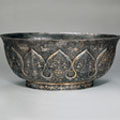 |
|
 |
 |
 |
 |
 |
 |
 |
 |
Tang and Liao Dynasty Metalwork
The renewed interest in metalwork and the use of gold and silver in Tang-period China illustrate the impact of foreign ideas and art forms on the culture. During the Tang dynasty (618-906), China was the economic, political, and cultural center of Asia, with ties extending from Japan to the Mediterranean world. Diplomatic emissaries, Buddhist monks, and traders flocked to China, fostering a cosmopolitan and eclectic culture that united China, Korea, and Japan in the 8th century. This cosmopolitanism is reflected in the arts of the Tang dynasty: the inclusion of foreigners among tomb figurines, the prominence of Central Asian dance and music, and the rise in the number of metal objects made all resulted from the Tang-period fascination with the foreign and the exotic. Although gold and silver in the form of hammered fragments had been used as inlay on bronzes as early as the Shang and Zhou dynasties, during the subsequent Han and Northern and Southern dynasties these metals were only occasionally used for jewelry and other types of ornament. It was not until the Tang dynasty that a large number of functional objects made of or decorated with gold and silver were made. The close contacts between China, Central Asia -- particularly Sogdiana (centered in present-day Uzbekistan), which had long-standing mercantile ties with China -- and Sassanian-period Iran played a critical role in the evolution of metalwork during the Tang period. |
 |
 |
| 1 thru 4 of 4 |
 |
| view text only list |
 |

Lobed Dish |
 |

Bowl |
 |

Stem Cup |
 |

Mirror |
 |
|
 |